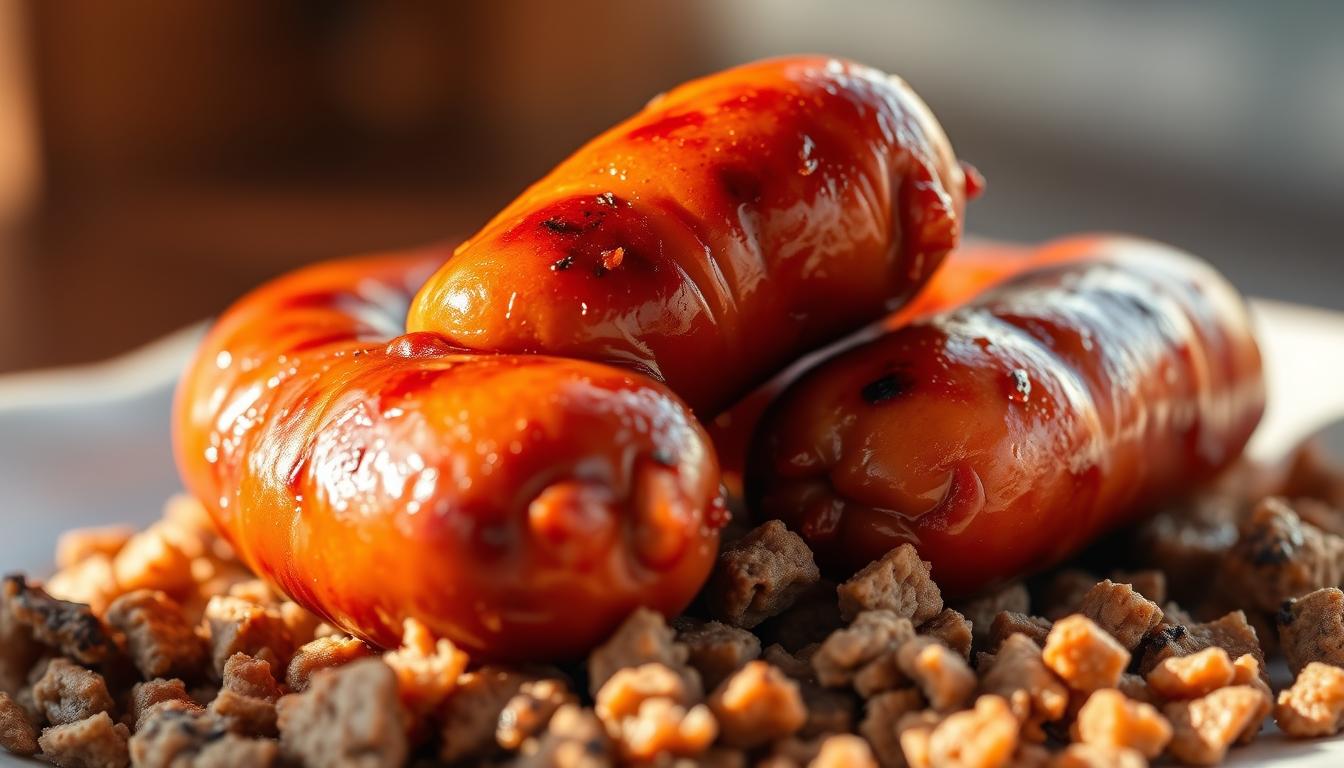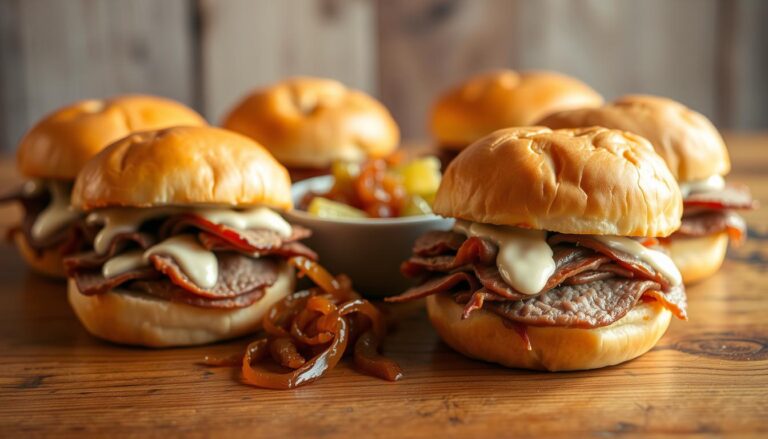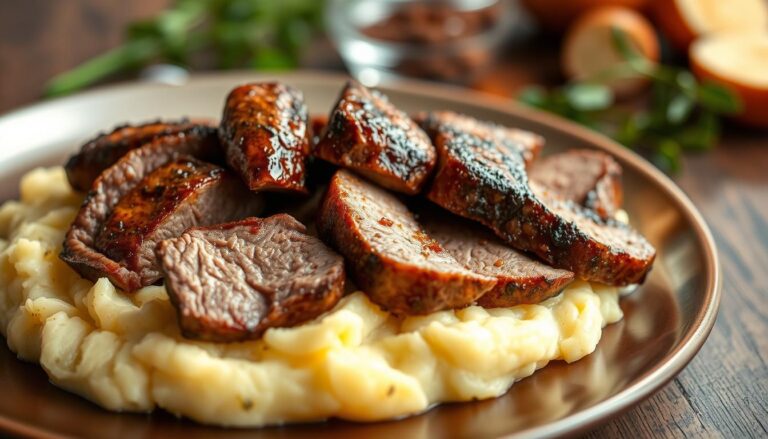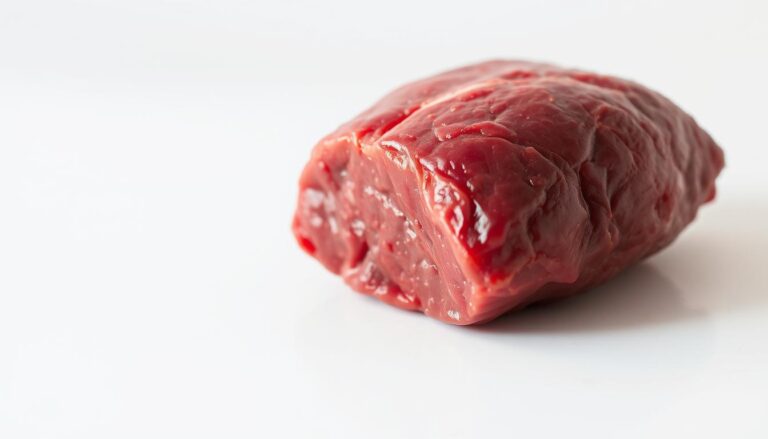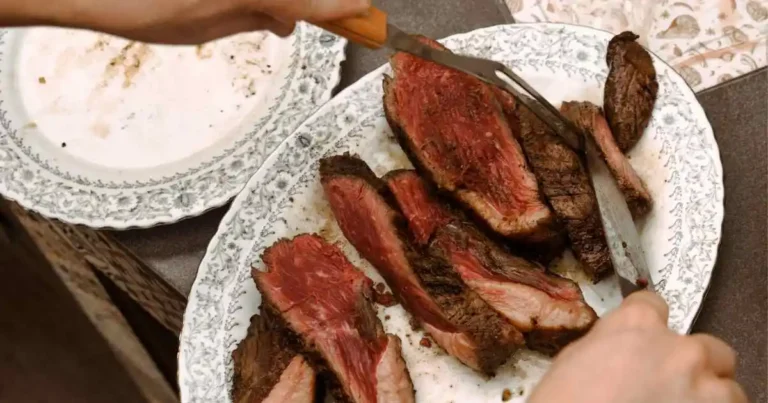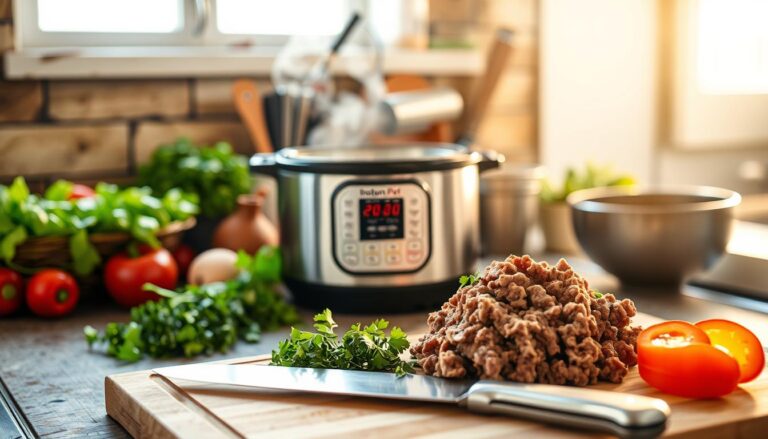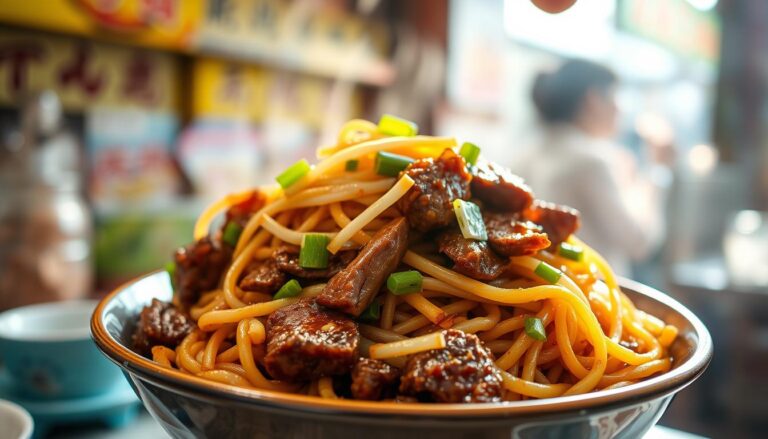Beef Breakfast Sausage: The Perfect Morning Protein
Some mornings feel rushed, and you just want a warm plate that comforts you like a hug. You can have that without pork by making patties that taste classic and true. This guide shows you a simple, repeatable way to get that flavor using ground beef and a smart spice mix.
Simple steps, big payoff: mix garlic powder, onion powder, smoked paprika, dried sage, thyme, red pepper flakes, and salt with 80/20 or 85/15 ground for juicy patties. Form ~2-ounce sausage patties so they hold together, then sear on a Blackstone griddle or a skillet for 4–5 minutes per side until the internal temp hits 160°F.
You’ll learn tips for oil choice, batch cooking, and reheating so weekday mornings feel easy. Use an air fryer for hands-off browning or freeze cooked patties for quick meals.
Table of Contents
Why You’ll Love This Beef Breakfast Sausage Recipe
A short spice blend turns simple meat into a reliable, flavorful patty every time. The mix of garlic powder, onion powder, smoked paprika, sage, thyme, salt, and red pepper flakes gives that classic diner taste without needing pork.
Protein-packed mornings you can meal-prep
Make a big batch on Sunday and heat patties all week for fast, filling meals. Use 80/20 ground beef for the best texture; 85/15 also works if you want leaner results.
Each patty cooks in about 4–5 minutes per side on a skillet or griddle. An air fryer needs roughly 7–9 minutes at 400°F.
Classic flavor without pork
The herb-forward profile of sage and thyme, plus smoked paprika, mimics traditional taste so you get true breakfast flavor while staying pork-free.
You can blend with turkey or pork if you like, but pure beef keeps texture juicy and straightforward. Adjust the red pepper flakes to match your spice preference.
- High-protein, freezer-friendly patties for quick weekday meals.
- Familiar seasoning with control over salt and heat.
- Simple to scale and reliable every time.
Quick Look: What You’ll Make and What You’ll Need
Before you start, take a moment to gather the few ingredients and tools that make this morning meal come together.
Ingredients at a glance: 80/20 (ideal) or 85/15 ground beef, garlic powder, onion powder, smoked paprika, dried sage, dried thyme, crushed red pepper flakes, and salt. Have a bit of oil ready—avocado or olive oil—or a mix of oil and butter for flavor and browning.
Tools
Use a large bowl to combine the ground meat and seasonings without overworking the mix. A cast iron skillet or sturdy skillet gives the best crust and even heat for searing patties.
- Instant-read thermometer to confirm 160°F doneness.
- Optional: a 2.5–3 inch cutter, jar, or biscuit cutter to stamp uniform breakfast sausage patties.
- Sheet pan or plate to stage patties before they hit the hot surface.
This simple setup keeps the prep short and the cooking window measured in minutes, so your morning routine stays practical and repeatable for the whole week.
Ingredients & Substitutions for Juicy Sausage Patties
A few deliberate choices in meat, herbs, and oil will make your patties reliably juicy and flavorful. Start by picking the right ground beef ratio, then layer seasonings so they blend evenly.
Fat ratios and texture
80/20 gives the best balance of flavor and moisture. Use 85/15 if you want leaner patties; they still stay tender if you avoid overmixing the meat.
| Ratio | Result | Tip |
|---|---|---|
| 80/20 | Juicy, rich | Best for crisp sear |
| 85/15 | Leaner, firmer | Don’t overwork |
Seasonings, heat, and swaps
Build classic breakfast sausage seasoning with garlic powder, onion powder, smoked paprika, dried sage, dried thyme, crushed red pepper flakes, and salt. Add a teaspoon of brown sugar for a touch of sweetness.
“Pre-mix dry seasonings so every bite tastes the same.”
- Swap fresh minced sage (about 1½ tbsp) for dried for brightness.
- Add marjoram, oregano, or black pepper to personalize the profile.
- Mix seasonings into the ground blend with your hands; a splash of water softens texture.
- Cook in avocado or olive oil, or use a mix of oil and butter for extra flavor.
How to Make Beef Breakfast Sausage (Step-by-Step)
Follow these clear steps to turn seasoned ground into consistent, flavorful patties. Start by combining dry spices so they blend evenly. This keeps each bite balanced and predictable when you cook.
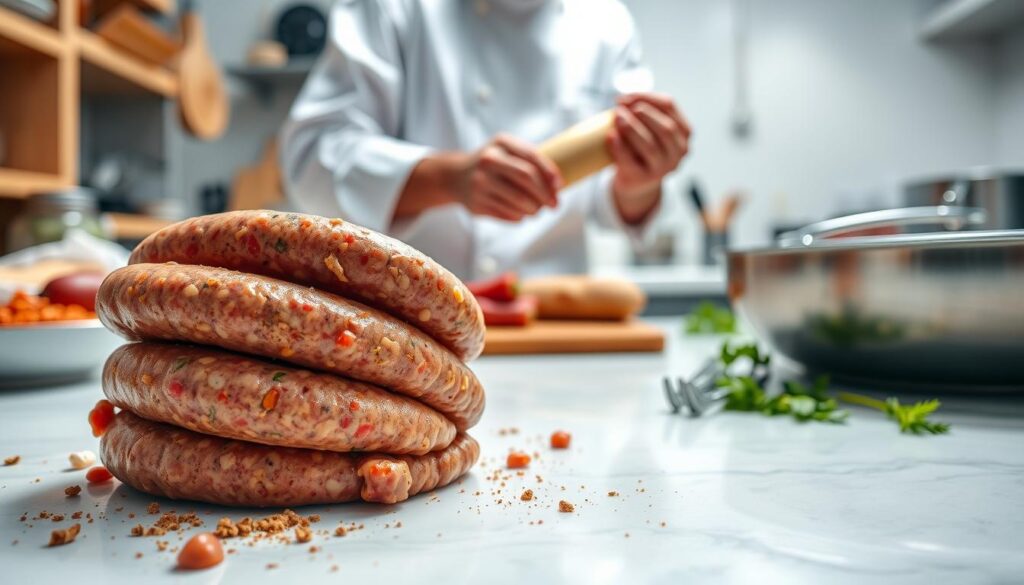
Prep and mix
Whisk garlic powder, onion powder, smoked paprika, sage, thyme, salt, and red pepper flakes in a small bowl.
Add the dry mix to the large bowl with the ground beef. Use your hands to fold gently until the meat looks evenly seasoned. Stop once combined to avoid a dense texture.
Form and cook
Shape tight discs of about 2 ounces so the patties cook at the same rate. A biscuit cutter helps make uniform sausage patties.
Heat a thin film of oil in a skillet over skillet medium-high heat. Add patties and cook patties about 4-5 minutes per side until well-browned and no longer pink.
- Watch edges for browning cues and flip once for best crust.
- Use an instant-read thermometer to confirm 160°F before serving.
- Let patties rest briefly so juices redistribute.
Skillet, Griddle, or Air Fryer: Choose Your Cooking Method
Pick the cooking tool that matches your morning rhythm—fast sear, hands-off air-fry, or wide griddle for feeding a crowd.
Skillet method: Preheat your cast iron or stainless over skillet medium-high heat. Add a thin film of oil and place patties in the pan. Sear until golden, about 4–5 minutes per side, and aim for 160°F internal temp before resting.
Griddle or Blackstone: Set a steady medium heat. Work in batches so the surface recovers. Cook patties 4–5 minutes per side and sear eggs alongside for a full plate.
Air fryer: Arrange sausage patties in a single layer and lightly spray tops. Air at 400°F for 7–9 minutes until browned and no longer pink. Add 2 minutes if cooking from frozen.
- Space patties so steam escapes and a crust forms.
- Flip once and watch color; adjust heat if they brown too fast.
- Keep seasonings the same across methods—add red pepper or extra pepper flakes as you like.
- Cook patties in batches to avoid steaming and to keep even heat.
Beef Breakfast Sausage Seasoning Variations
A balanced seasoning foundation lets you experiment without losing the traditional diner taste. Start from the classic profile—sage, thyme, garlic and onion powders, smoked paprika, and salt—and then make targeted swaps to suit your palate.
Swap-ins: marjoram, oregano, black pepper, fresh sage
Marjoram or oregano adds a floral, herb-forward note that pairs well with ground meat and keeps the base familiar to pork-based blends.
Use fresh sage (about 1½ tablespoons) instead of dried when you want a brighter herbal pop. Add black pepper to taste for a sharper finish.
Make it mild or spicy: adjust pepper flakes or cayenne
You control heat by changing red pepper flakes or adding a pinch of cayenne. Increase black pepper for a bolder edge without extra heat.
- You’ll start with a breakfast sausage seasoning foundation, then tailor it to your taste.
- Add a touch of brown sugar for a diner-style sweetness that balances savory and heat.
- Stir in a splash of water to help the seasoning bloom and keep the patties tender.
- Mix only until combined and test-cook a tiny patty to dial in salt and spice.
“Keep ratios similar to pork breakfast blends if you want that classic profile, then note what you loved for next time.”
Make-Ahead, Storage, and Freezing Tips
Smart storage keeps flavor and texture intact for days or months. Plan a weekend prep session so you can grab hot or reheated patties quickly on busy mornings.
Fridge short-term: Cool cooked patties completely, then move them to an airtight container in the refrigerator. Store for 3–4 days so you can rely on safe, tasty meals during the week.
Freeze like a pro
Arrange raw or cooked portions in a single layer on a sheet pan until firm. Transfer to a freezer bag or another airtight container and label with the date. Keep frozen up to 2–3 months.
Reheating and quick use
Reheat in a skillet over medium heat to keep moisture in, or use the microwave at 50% power for even warming. An air fryer works well for crisp edges—add a minute or two if needed.
- Portion before freezing so you pull only what you need.
- Label and date each container to track storage days.
- Cook patties from frozen with a couple extra minutes, or thaw overnight for faster searing.
- Keep raw and cooked batches sealed separately to avoid flavor transfer.
Serving Ideas: From Classic Breakfast to Brunch Boards
A few smart sides will lift these savory patties into a full brunch spread. You can keep things classic or build a more adventurous board depending on time and guests.
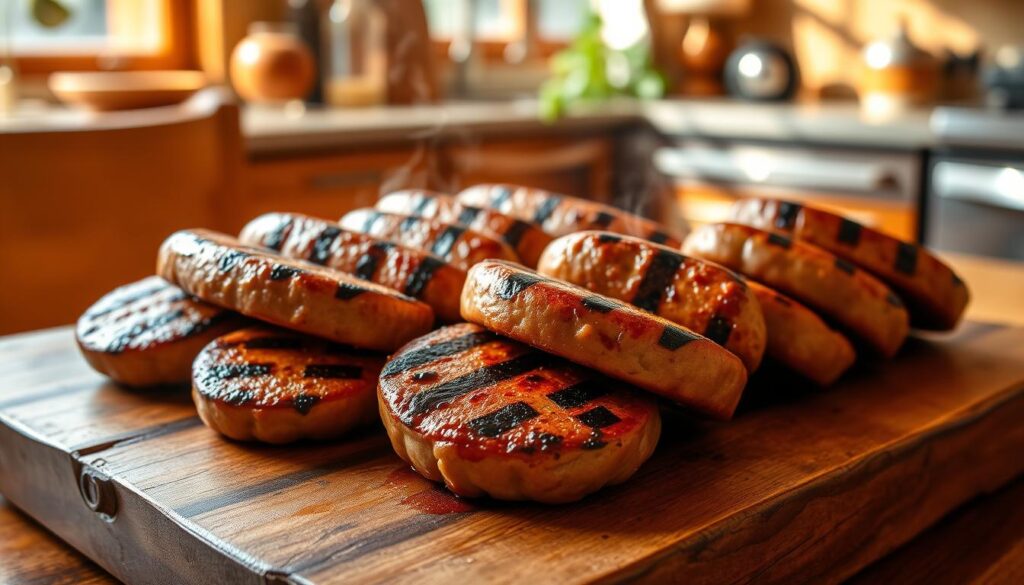
Pairings: eggs, pancakes, waffles, and breakfast potatoes
Plate patties with eggs for a hearty, balanced meal that scales for family or guests. Sunny-side or scrambled eggs work well.
Add pancakes or waffles and a heap of crisp breakfast potatoes when you want a diner-style platter. Patties also pair nicely with biscuits and fresh berries.
Low-carb sides: salads, Brussels sprouts, or mashed cauliflower
For a lighter option, serve patties with a bright salad or roasted Brussels sprouts. Mashed cauliflower offers a creamy, low-carb side that keeps the flavors in focus.
Use sauces like maple, ketchup, or hot sauce, and a pinch of red pepper if you like heat. You can also tuck halves into sandwiches with cheese and a runny egg for handheld convenience.
- Build brunch boards with patties, sliced fruit, cheeses, and small bowls of condiments for DIY plates.
- Offer warm biscuits or toast to soak up juices and add texture.
- Use smaller patties as appetizer bites between courses.
“Keep a mix of fresh, sweet, and savory elements so each plate feels balanced and inviting.”
Pro Tips, Timing, and Safety
A few practical habits—timing, gentle mixing, and steady heat—produce consistent results. Follow these tips so your patties stay juicy and safe without guessing at doneness.
Minutes per side and avoiding overmixing
Cook thin patties about 3–4 minutes per side. Thicker patties need roughly 4–5 minutes per side to brown without drying.
Mix the meat just until the seasoning is distributed. Overmixing tightens proteins and makes the texture dense.
Internal doneness: aim for 160°F
Use an instant-read thermometer and target 160°F and no pink inside. That temperature ensures ground meat safety for the U.S.
Season in stages with salt and pepper, then cook a tiny tester to adjust seasoning before forming the whole batch.
Troubleshooting texture: binding, shaping, and preventing dryness
Shape patties firmly enough to hold together but not so tight they become dense. Space patties so steam escapes; crowding causes steaming instead of searing.
Use a cast iron or heavy skillet for steady heat and even browning. If the surface darkens too fast, lower the heat.
Add a teaspoon or two of water to the mix for a softer bite, or a touch of oil in the pan to boost browning.
“Test one small patty first—it’s the fastest way to dial in salt, spice, and timing.”
- You’ll target minutes per side based on thickness to balance crust and juiciness.
- You’ll aim for 160°F and no pink to meet safety while keeping texture tender.
- You’ll rely on consistent sausage seasoning, with a pinch of pepper flakes or sage for finish.
Conclusion
This approach makes protein-forward mornings simple and repeatable. With a reliable seasoning of sage, thyme, garlic and onion powders, smoked paprika, red pepper flakes, and salt, you’ll hit that classic diner note. Choose 80/20 or 85/15 ground beef and shape evenly for consistent cook time and texture.
Cook to 160°F on skillet, griddle, or air fryer. Store extras in an airtight container in the fridge for 3–4 days or freeze for longer. Reheat gently in a skillet or microwave to preserve juiciness.
You now have a repeatable method for beef breakfast sausage that fits meal prep and weekend brunch. Use these recipes often, tweak small details you like, and enjoy reliable, well-seasoned beef breakfast each time.

